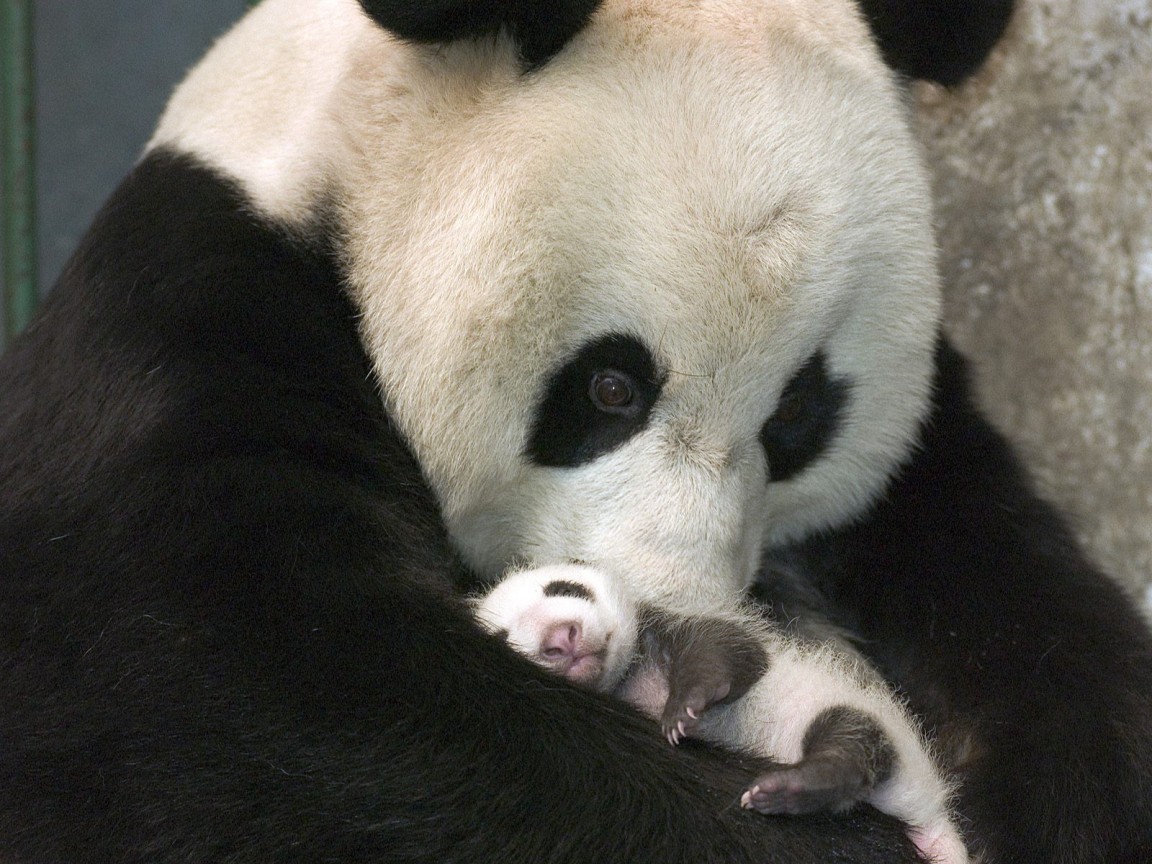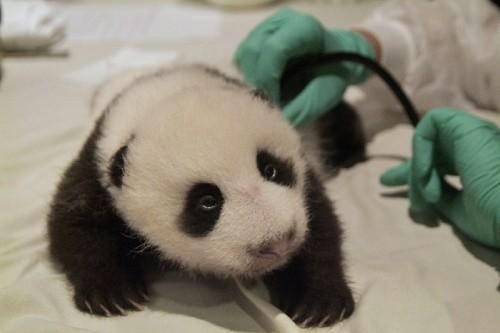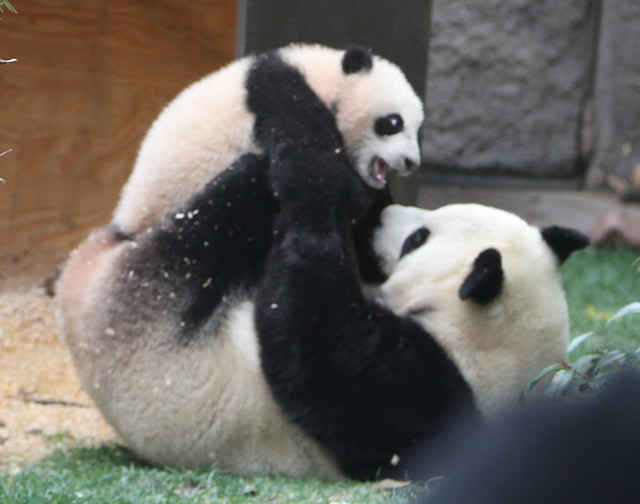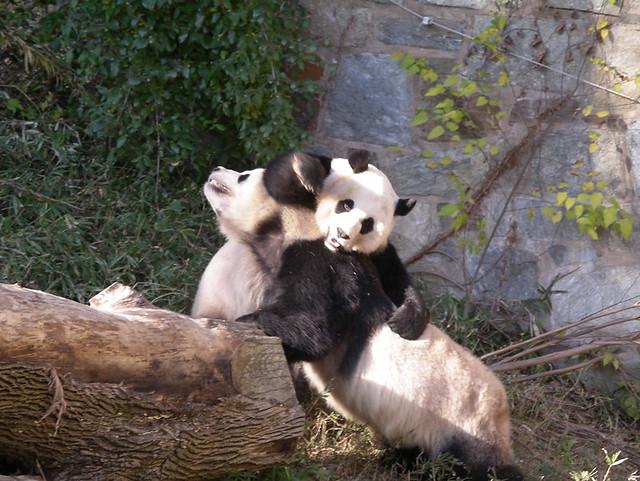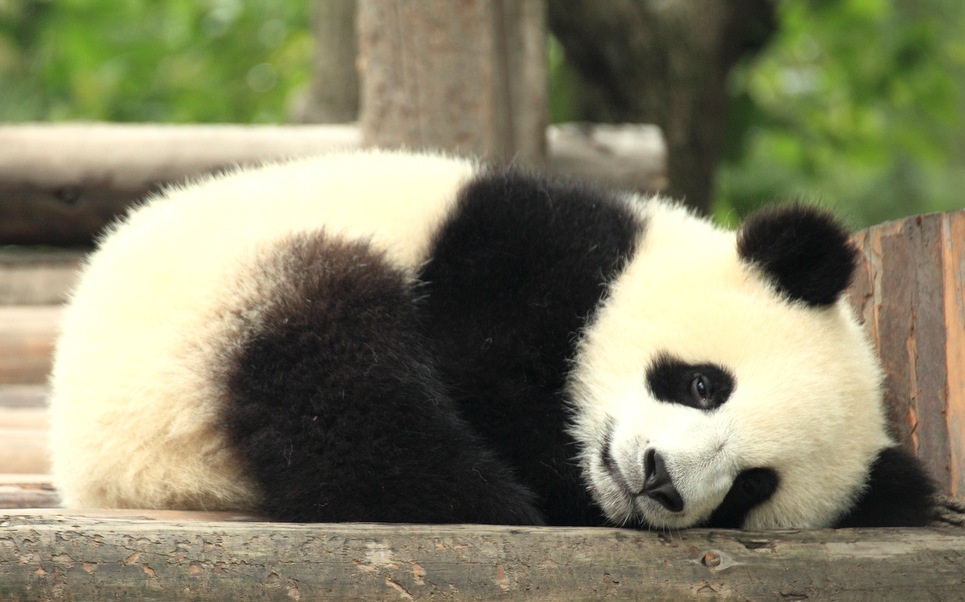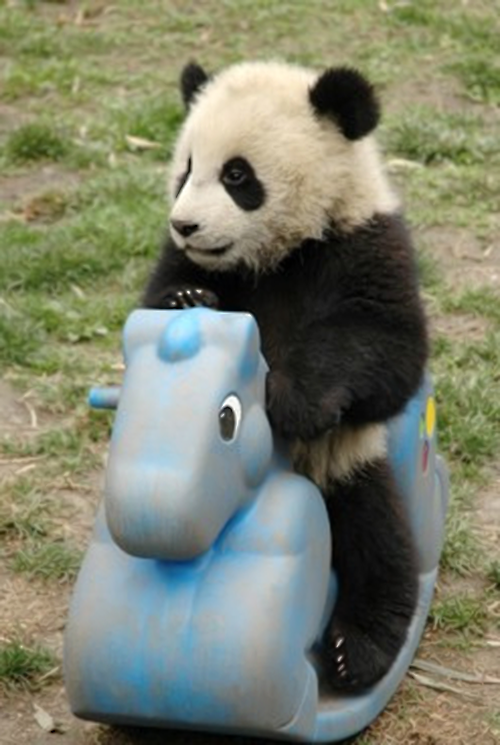Interesting Facts
|
~ The red panda is commonly
called the wah because of the "wah" call that it makes. It also has the
common name fire fox because of its reddish fur and fox-like snout.
~ The red panda weighs 5%
of the giant panda's weight
 . .
~ Male red pandas will
fight with each other by standing on their hind legs and boxing with their
claws.
~ Red pandas use their
tongues to detect different scents.
~ The first live red panda
was put in the London Zoo on May 22, 1869.
~ Red pandas are considered
arboreal animals, because they are usually seen resting in trees.
~ Red pandas do not like
water.
~ To stay warm, red pandas
sometimes roll into a ball, with their heads tucked beneath their chest and
nose pushed between their hind paws.
~ If a red panda's den is
discovered by a human more than once, the mother panda may respond by eating her
cubs.
~ The red panda's tail is
almost the same length as its body.
~ Male red
pandas do not help take care of their cubs.
|
bamboo

Wednesday, November 27, 2013
Interesting Facts About Red Pandas
Tuesday, November 26, 2013
BABY PANDA ESCAPES
These baby pandas keep their babysitter busy as they keep escaping from their crib.
License: Standard YouTube license
RED PANDA ESCAPES FROM ZOO
Kai Jackson explains how Twitter played a key role in the search.
The wayward red panda has been returned to its natural habitat, safe
As critters go, this one is relatively small, but don’t be fooled. Rusty is one popular red panda.
And when the National Zoo discovered the little guy escaped, it was a big deal, and the panda hunt in Washington D.C. began.
Published June 25 2013
License: Standard YouTube license
The zoo says Rusty, a male, escaped some time Monday morning. The zoo turned to the citizens of Washington and social media for help. A Twitter timeline with Rusty spottings tracked the panda’s movements.
The response was overwhelming, and within hours, zookeepers cornered and captured the red panda in a neighborhood in Adams Morgan. “We were able to walk
 up to him. We sent the keepers with which he is most familiar,” Smith said.
up to him. We sent the keepers with which he is most familiar,” Smith said.“So the keepers called his name, he was familiar to them. They calmed him down. We were able to approach him with a net. Captured him in a net,” she continued.
Red pandas aren’t in the bear family, but they are tree dwellers and excellent climbers. It’s suspected, but not definitive, that Rusty may have avoided the electric fence in his habitat and escaped using a low hanging branch.
“Well, we don’t know right now in all honesty. Complete honesty, we do not know. That habitat has housed red pandas for several years,” said Pamela Baker-Masson, spokeswoman. “No one has escaped from it before.”
Veterinarians are now examining Rusty to make sure he’s okay and he wasn’t hurt during his adventures. They say the biggest danger to him would have been had he eaten something other than the bamboo he normally eats.
Red pandas are listed as a vulnerable species.
Monday, November 25, 2013
Sunday, November 24, 2013
Saturday, November 23, 2013
Thursday, November 14, 2013
Wednesday, November 13, 2013
Toronto Zoo Giant Pandas
Giant Panda
Ailuropoda melanoleuca
Ailuropoda melanoleuca, meaning "cat-footed, black and white animal".What is black and white and loved all over? The giant panda of course!
The giant pandas are here!
For the second time ever, two giant pandas are in Canada. The first time was in 1985, when two giant pandas spent the summer at the Toronto Zoo. This time, the pandas will be in Canada for at least 10 years (a minimum of five years at the Toronto Zoo and five years at the Calgary Zoo) as of March 2013. The two giant pandas that have joined Toronto Zoo's family are Er Shun (female) and Da Mao (male). The name 'Er Shun' means 'Double Smoothness'. Er Shun was born at the Chongqing Zoo on August 10, 2007 and was raised by her mother. Da Mao was born on September 1, 2008 at the Chengdu Research Base of Panda Breeding. This pair was chosen as a good genetic match for breeding.
In China, the giant panda is a national treasure. It has been the World Wildlife Fund's (WWF's) logo since 1961. The inspiration for this logo came from Chi-Chi, a giant panda that had arrived at the London Zoo in 1961, the same year WWF was formed.
The giant panda is one of the most beloved animals in the world and is perhaps the most powerful symbol in the world for wildlife conservation. It is also one of the most endangered species in the world, with only around 1,600 left in the wild.
History:
The giant panda was not known outside China (and probably hardly known within China) until 1869 when Père Armand David, missionary naturalist and explorer, first described a giant panda specimen, that had been shot by Chinese hunters, to the western world. But, it was not until 1916 that the first westerner, Hugo Weigold, saw a live giant panda. After that, it was another 14 years before the next sighting was reported. Once discovered, the killing of giant pandas became a goal of western museum collectors and hunters, beginning with Kermit and Theodore Roosevelt, Jr., sons of Teddy Roosevelt, who shot a giant panda on an expedition sponsored by the Chicago Field Museum. In 1936, Ruth Harkness, widow of the wealthy adventurer William Harkness, was the first person to export a giant panda alive to the USA. This panda, Su Lin, ended up at Chicago's Brookfield Zoo, where she died of pneumonia in 1938. Over the next 15 years at least 16 giant pandas were exported to western zoos, but these zoos did not have the expertise to properly look after them nor fresh bamboo readily available, therefore none survived beyond 10 years of age.The exportation of giant pandas from China stopped in 1949 with the Cultural Revolution and the formation of the People's Republic of China. A few animals were sent to zoos in Europe and North Korea. The re-initiation of diplomatic relations between China and the USA resulted in a 1972 gift of two giant pandas to the Smithsonian's National Zoo in Washington, DC. Similar state gifts of giant pandas then went to Japan, France, the UK, Mexico, Spain and Germany.
Today, the North American zoos that have pandas include: the Smithsonian's National Zoo (Washington, DC), San Diego Zoo (California), Zoo Atlanta (Georgia), Memphis Zoo (Tennessee), and Chapultepec Zoo (Mexico City).
Distribution:
Today, wild pandas live only in portions of six isolated mountain ranges in central China, specifically in the provinces of Sichuan, Gansu and Shanxi. They live in temperate montane forests with dense stands of bamboo at altitudes of 1,500 to 3,000 meters above sea level. In the past, their ancestors ranged throughout most of southern and eastern China, with fossils indicating presence as far south as Myanmar and Vietnam and stretching north nearly to Beijing.Adaptations:
Giant pandas have developed unique adaptations related to having lived in the bamboo forests for millions of years. Because of their low metabolic rate and sedentary lifestyle, giant pandas are able to subsist on a diet of bamboo from which they derive little protein and little energy. The panda's molars and premolar teeth are wider and flatter than those of other bears. These teeth and their powerful jaws allow pandas to crush and grind the tough, fibrous bamboo. Its' round face is the result of the powerful jaw and jaw muscles. The stomach walls are extremely muscular to help digest the woody diet and the gut is covered with a thick layer of mucus to protect against splinters. An extra, opposable digit (thumb) on the front paw is actually a modified sesamoid (wrist) bone that enables the panda to dexterously grasp bamboo stalks. In the past the black and white markings on giant pandas may have helped them to blend into their snowy and rocky surroundings to avoid natural predators of which they have none today. Unlike other bears, pandas do not hibernate, but will shelter temporarily in hollow trees, rock crevices and caves during the winter.Diet:
In the wild, a giant panda's diet is 99% bamboo. The other 1% consists of other grasses and occasionally small rodents or musk deer fawns. At the Toronto Zoo the pandas will be fed a diet that will consist of bamboo, leaf eater biscuits, dog chow, apples and vitamins. Bamboo will make up 80 – 90% of their diet and they will be offered 42 to 64 kg of bamboo each day. A giant panda's digestive system is more similar to that of a carnivore than a herbivore, and therefore most of the bamboo goes undigested, passing quickly through the digestive tract (giant pandas relieve themselves dozens of times a day). To make up for their inefficient digestion, a panda needs to consume a comparatively large amount of food in order to extract enough nutrients. In order to obtain this much food a panda must spend 10 to 16 hours a day foraging and eating. The rest of its time is spent mostly sleeping and resting. Approximately 600 to 900 kg of bamboo will be delivered to the Zoo three times a week. It will be transported and stored in cold storage refrigerators.Interesting facts about bamboo:
When bamboo plants reach maturity they flower and produce seeds, and then the mature plant dies. It takes a long time for these seeds to grow into plants large enough for pandas to eat. Giant pandas can eat 25 different types of bamboo, but they usually eat only the four or five that grow in their home range. The unusual thing about bamboo is that all of the plants of one species growing in an area will bloom and die at the same time. When those plants die, pandas move to another area. But now, with humans taking up much of the panda's habitat, pandas are often unable to move to another area and may face starvation.Reproduction and Development:
Female giant pandas are monoestrous, which means they have only one reproductive cycle per year (usually March to May) and that is the only time the female is receptive to the male and that is only for a period of 24 to 72 hours. Calls and scents attract males and females to each other.The gestation period lasts about 45 days. The total 'pregnancy' however, can last 3 to 51/2 months if there is delayed implantation of the fetus. Delayed implantation is when a fertilized egg does not immediately implant on the mother's uterine wall, but instead "floats" round in her reproductive tract for varying lengths of time. No development takes place during this time and as a result the normal gestation period is extended. As a result, the actual gestation period of giant pandas is not exactly known. Delayed implantation gives the giant panda more control over when cubs are born, which allows them to give birth at the time of year that offers the best chance of survival for their young, usually in August and September.
Females may give birth to two panda cubs, but only one is cared for by the mother, likely because she is unable to suckle both. The dependence of a young panda on their mother prohibits breeding the following spring so that a female will only produce an offspring every other year.
Panda cubs are born blind and extremely immature, weighing only 80-200 grams, and are about the size of a stick of butter. They are pink in colour, with short sparse white hair, and are 1/900th the size of their mother, one of the smallest newborn mammals relative to its mother's size. After about a month, the typical black and white colour pattern develops. They do not open their eyes until they are 6 to 8 weeks of age and are not able to crawl until about three months of age. They are fully weaned at 8 to 9 months of age. Most pandas leave their mothers when she conceives again, usually at about 18 months of age. Giant pandas are ready to breed between 4 - 8 years of age and may be reproductive until about age 20. Within zoos and breeding centers, artificial insemination is used to produce offspring from non-compatible pairs and mates separated by long distances in order to maintain genetic diversity. Cryopreserved sperm is able to be shipped between institutions for artificial insemination.
If two cubs are born the mother will only look after one of them, so in captivity keepers will help raise any twin cubs using a method called "twin swapping". One baby is left with the mother and the keepers switch the twins every few days so each one gets care and milk directly from the mother.
Threats to Survival:
Giant pandas are listed as Endangered on the International Union for Conservation of Nature (IUCN) Red List of Endangered Species. Although recent survey results differ, best estimates indicate a total wild population of approximately 1,600 giant pandas in small isolated populations, confined to high ridges. One of the main reasons that pandas have become endangered is habitat destruction. As the population in China continues to grow, panda habitat gets taken over by development, pushing them into smaller and less livable areas. Habitat destruction also leads to food shortages. Pandas feed on several varieties of bamboo at different times of the year. If one type of bamboo is destroyed by development, it can leave the panda with nothing to eat during the time it normally blooms, increasing the risk of starvation. Besides habitat loss, a further threat is the periodic, large-scale die-off of bamboo at intervals of 15 to 120 years.Poaching of pandas was a serious problem in the past, but is no longer considered a threat since the Chinese government has adopted conservation initiatives for this species. Today, there are 63 panda reserves in China that are attempting to preserve the pandas' habitat and to support breeding programs. Logging has been banned in these reserves and reforestation programs are being implemented to reclaim agricultural areas. Corridors are being created to connect fragmented habitat.
As well as in Asia, many zoos in Australia, Europe and North America are involved in protecting the giant panda from possible extinction. Captive breeding success with giant pandas has increased dramatically in the last 20 years due to technology and reproduction methodology advancements and the hard work of international zoos and research facilities working with panda scientists and reserves in China. There will be over 350 giant pandas in captivity when the 2012 breeding season in completed. A new target of 500 individuals has been set to support reintroduction studies which are returning pandas to the wild. This research is currently underway and is very promising for giant panda conservation efforts. The Toronto Zoo supports giant panda conservation projects through the Toronto Zoo's Endangered Species Reserve Fund.
Toronto Zoo Research Plans:
The Toronto Zoo will co-operate with other zoos that have giant pandas to expand the numbers needed for scientific research and collaboration efforts. This will involve studies in animal behavior, enrichment, nutrition, veterinary science, and reproduction.The Toronto Zoo has an extensive Behavioral Enrichment Program. Giant panda behavioral enrichment studies will be designed and conducted.
The Toronto Zoo's Wildlife Nutrition Centre will coordinate studies in giant panda physiology and nutrition as well as bamboo propagation.
The Toronto Zoo offers a three year Doctor of Veterinary Science (DVSc) post graduate program with the University of Guelph. There will be an opportunity for studies related to the giant panda program. Breeding of giant pandas in captivity has been difficult for a variety of reasons, however giant pandas are one of the few species where assisted reproductive technologies have been instrumental in improving reproductive success. Use of urinary hormone monitoring techniques for estrus detection and artificial insemination techniques with fresh and frozen-thawed sperm has resulted in many successful births over the past 10 years at various zoos and breeding facilities around the world. Despite these successes, further research is still necessary to ensure the long-term preservation of giant pandas in captivity and in the wild. The Toronto Zoo's reproductive physiology program has the equipment and technical expertise to play a major role in contributing to the preservation of this species.
Panda Facts:
- 99% of a giant panda's diet consists of bamboo
- A giant panda's digestive system is more similar to that of a carnivore than a herbivore, yet they have adapted to a vegetarian diet of bamboo
- A giant panda may eat 12-38 kg of bamboo a day
- In the wild, a giant panda spends 10 to 16 hours a day foraging and eating. The rest of its time is spent mostly sleeping and resting
- Female giant pandas are only receptive to breeding once a year for a period of 24 to 72 hours
- A giant panda is born pink, hairless, blind and is 1/900th the size of its mother (about the size of a stick of butter)
- Unique physical features that help pandas to hold, crush and eat bamboo are broad, flat molar teeth and a enlarged wrist bone that functions as an opposable thumb
- Giant pandas do not hibernate like other bears do
- Giant pandas make a bleating sound similar to the sound a lamb or young goat (kid) would ma
Subscribe to:
Posts (Atom)





